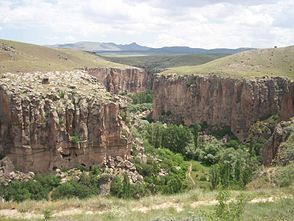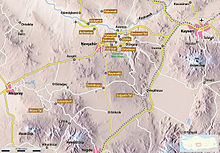Ihlara valley
| Ihlara Valley - Peristrema Valley | ||
|---|---|---|
| location | Güzelyurt district in Aksaray Province ( Turkey ) | |
| Mountains | Cappadocia | |
| Geographical location | 38 ° 16 ' N , 34 ° 18' E | |
|
|
||
| length | 15 km | |
The Ihlara Valley (also Peristrema Valley ; Turkish Ihlara Vadisi) is a 15 km long and up to 150 m deep gorge in the southwest of the Turkish region of Cappadocia in the Güzelyurt district of the Aksaray province . There are around 50 rock-hewn churches and numerous cave structures in the valley .
Origin and location
The gorge was dug by Melendiz Çayı in prehistoric times . It lies between the places Ihlara in the southeast and Selime in the northwest. At the northern end of Ihlara, a staircase with almost 400 steps leads over 100 m deep into the gorge. The valley has been the settlement area of Byzantine monks since the 7th century, who dug their houses and churches in the tuff rock that was formed by the eruptions of Hasan Dağı . The former Greek name Peristrema ("wound around") of the place Belisarma, which is about halfway from Ihlara to Selime, gave the valley its name.
Churches
The churches in the Peristrema Valley can be divided into two groups. The first are the churches around the town of Ihlara, which are decorated with paintings of a local Cappadocian direction, which has eastern influences from Persia and Syria. Most of them were created in pre-Iconoclastic times, but were decorated with new paintings in later times. The other group, around Belisarma, is decorated mainly in the Byzantine style of the 10th and 11th centuries.
The first group includes, among others
- the Ağaçaltı Kilisesi ("Church under the Tree"), a cross-shaped church carved into the rock, probably from the 7th century, in whose dome a scene of the Ascension can be seen. This pre-iconoclastic representation has survived the time of the iconoclasm.
- the Yılanlı Kilise ("Snake Church"), also a cross-domed church with a noticeably long apse . In the narthex there are scenes of hell that are dated to the 9th century, including four naked sinful women who are surrounded by serpentine monsters. The name of the church comes from this illustration.
- the Sümbüllü Kilise ("Hyacinth Church"), probably from the 10th century. The T-shaped church shows the transition to the Byzantine style. Your wall paintings show, among others, Emperor Constantine with his wife Helena. The articulated, magnificent outer facade, on the other hand, shows oriental influence.
Belong to the second group
- the Direkli Kilise ("pillar church"). The three - aisled cross - domed church was built in the 10th century. The vault is supported by four high pillars adorned with portraits of saints. One of the few inscriptions found in the valley reports on the foundation of the church at the time of the Byzantine emperor Basil II , who ruled from 976-1025.
- the Karagedik Kilisesi ("Church with the Black Breach"), a cross- domed church with four pillars from the 11th century, built from bricks and trachyte blocks , which has been badly damaged and has only a few faded remains of painting.
- the Kırkdamaltı Kilisesi ("Church under 40 Roofs" or "St. George's Church"), which can be dated between 1283 and 1295 based on an inscription. This makes it the last known testimony of Christian architecture in the Ihlara Valley until the construction of the church began again by the Greeks living here in the 19th century. In addition to depictions of Saint George, one of her paintings shows the Byzantine consul Basileos Giagupes, who was also an emir, in Seljuk costume with a turban and his wife Thamar, a Georgian princess. The accompanying inscription mentions both the Seljuks - Sultan Masud II. And the Byzantine emperor Andronikos II. , Which is regarded as evidence that at this time Christians and Muslims could live together peacefully in Cappadocia.
The Niğde Archaeological Museum shows the mummies of a woman and four children, which, according to the inscription, were found in the Ihlara Valley and date from the 10th century. The Aksaray Museum also exhibits mummies from the Ihlara Valley.
See also
literature
- Peter Daners, Volker Ohl: Cappadocia . Dumont, 1996, ISBN 3-7701-3256-4
- Marianne Mehling (Hrsg.): Knaur's cultural guide in color Turkey. Droemer-Knaur, Munich 1987, ISBN 3-426-26293-2 .
- Robert G. Ousterhout: A Byzantine Settlement in Cappadocia. Dumbarton Oaks, 2005, ISBN 0-88402-310-9 , on GoogleBooks





